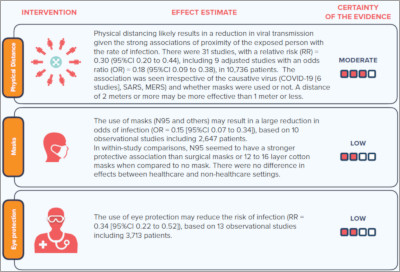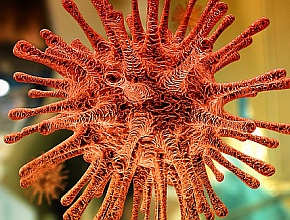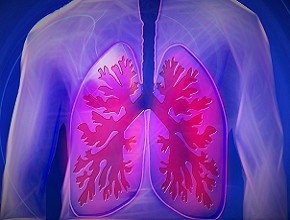SARS-CoV-2: Physical distancing and face and eye protection in preventing viral transmission
Click here for an interview with Dr Derek Chu, the first author of the study.
Severe acute respiratory syndrome coronavirus 2 (SARS-CoV-2), which is responsible for the current pandemic and causes coronavirus disease 2019 (COVID-19), is spread from person to person through close contact. Current evidence indicates that the mode of transmission is by large respiratory droplets at mucosal sites and potentially through fine respiratory aerosols. It is uncertain whether and to what extent person-to-person physical distancing and barrier methods, specifically facial masks or eyewear, will prevent or limit viral transmission.
This systematic review and meta-analysis, funded by the World Health Organization (WHO), assessed the effect of physical distancing and the use of masks and eye protection on the transmission of 3 coronaviruses: SARS-CoV-2, responsible for COVID-19; SARS-CoV-1, responsible for SARS; and MERS-CoV, responsible for Middle East respiratory syndrome (MERS). There were 44 observational comparative studies included (no randomized controlled trials) that assessed health-care and non–health-care (community-based) settings, totaling 25,697 patients from 16 countries. The studies were assessed using the GRADE (Grading of Recommendations, Assessment, Development and Evaluation) methodology.
The main findings:
- Virus transmission was lower with physical distancing ≥1 meter than with <1 meter, with an adjusted odds ratio (AOR) of 0.18 (95% CI, 0.09-0.38). Virus transmission decreased as a function of increasing distance, as expressed by a change in the relative risk (RR) for transmission per 1 meter of distance of 2.02 (95% CI, 1.08-3.76).
- Virus transmission was lower with the use of any facemask, with an AOR of 0.15 (95% CI, 0.07-0.34). However, the use of N95 or similar facemasks provided a lower risk for viral transmission (AOR, 0.04; 95% CI, 0.004-0.300) than disposable surgical or reusable 12- to 16-layer cotton masks (AOR, 0.33; 95% CI, 0.17-0.61).
- Virus transmission was lower with the use of eye protection (goggles and face shields, with one study using eyeglasses), with an AOR of 0.22 (95% CI, 0.12-0.39).
In terms of strength of evidence, studies assessing physical distancing provided moderate certainty of evidence, whereas those assessing facemasks and eye protection provided low certainty of evidence.
This meta-analysis suggests that effective methods used to prevent person-to-person transmission of SARS-CoV-2 include physical distancing of at least 1 meter, with added benefit of 2-meter distancing; the use of facemasks, especially N95 or similar type; and the use of eye protection.
Infographics
Click to view the full image.
Infographic summarizing findings of The Lancet publication courtesy of the meta-analysis authors.
Click to view the full image.
Infographic summarizing findings of The Lancet publication.
 English
English
 Español
Español
 українська
українська













